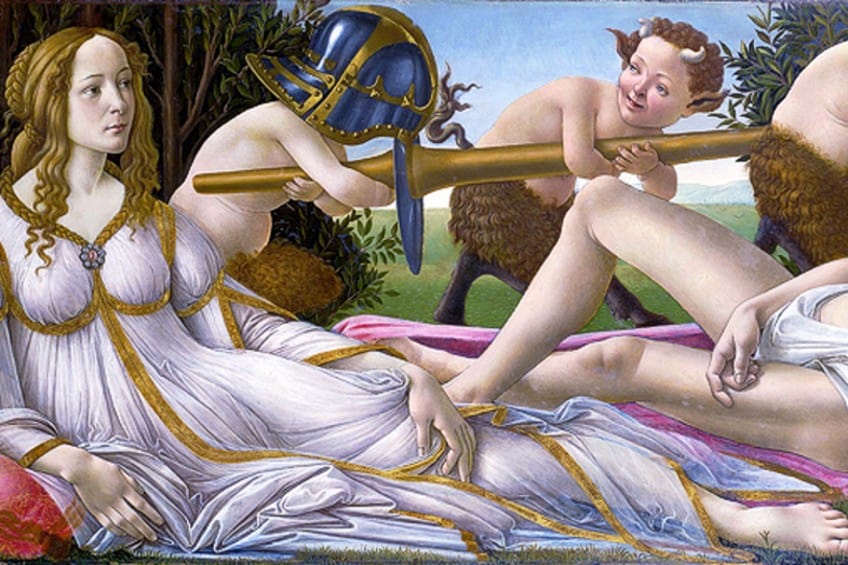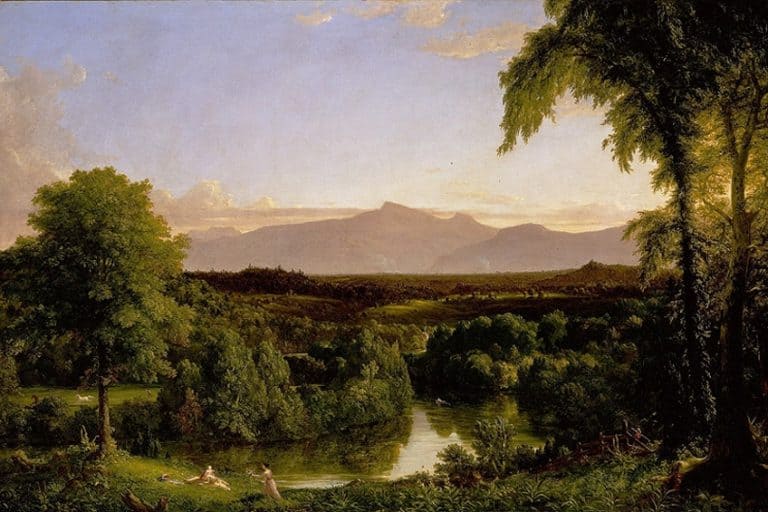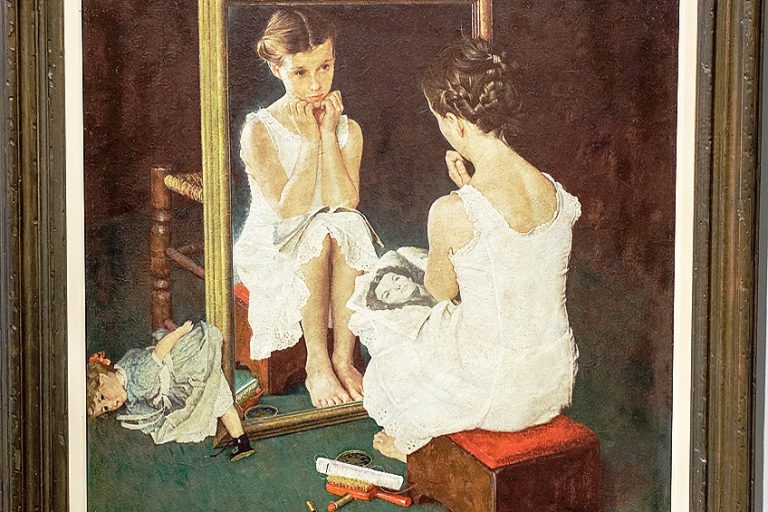“Venus and Mars” by Sandro Botticelli – A Closer Look at the Work
A marriage, a mythological tale, and a match made in a beautiful landscape, with a few funny satyrs – the scene is set. This article will explore the early Renaissance painting, Venus and Mars by Sandro Botticelli (c. 1485), in more detail below.
Artist Abstract: Who Was Sandro Botticelli?
The Early Renaissance artist known as Alessandro di Mariano di Vanni Filipepi, more commonly known as Sandro Botticelli, was born around the year 1445 and died on May 17, 1510, in Florence, Italy. Some of his teachers included Fra Filippo Lippi and reportedly Andrea del Verrocchio.
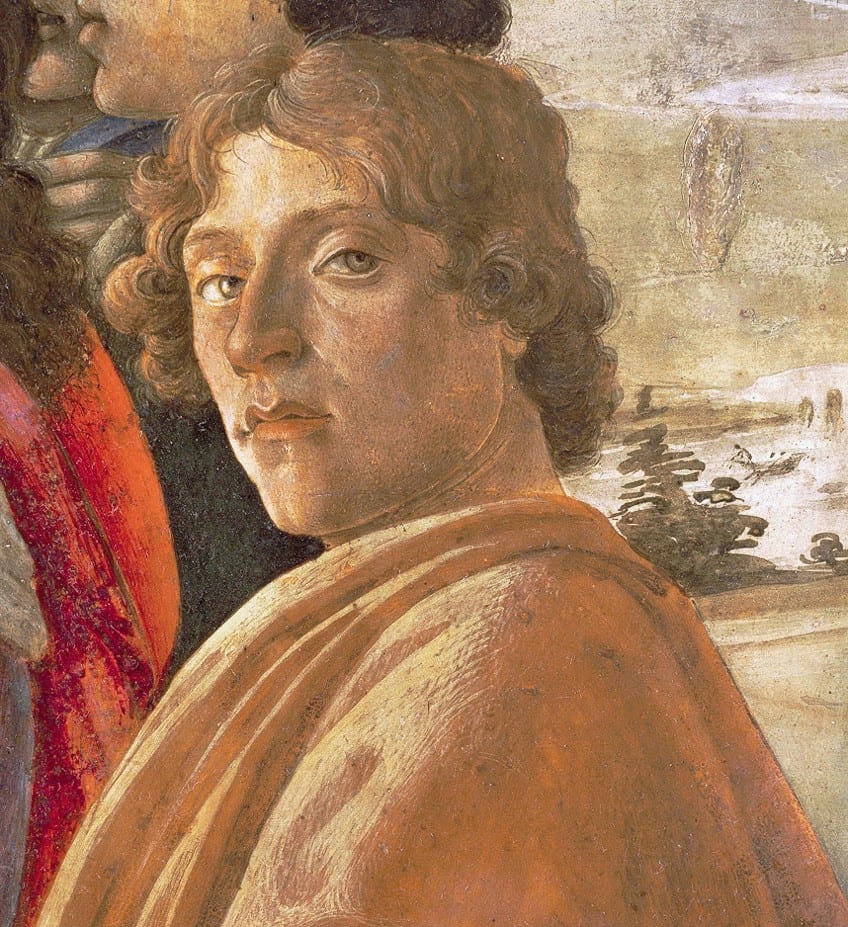
He was known for painting religious and mythological subject matter and received numerous commissions throughout his art career and had connections with the Medici family. Some of his famous artworks include Pallas and the Centaur (c. 1482), Primavera (c. 1482), Magnificat Madonna (c. 1483), and The Birth of Venus (c. 1485).
Venus and Mars (c. 1485) by Sandro Botticelli in Context
| Artist | Sandro Botticelli (c. 1445 – 1510) |
| Date Painted | c. 1485 |
| Medium | Tempera and oil on poplar |
| Genre | Mythological painting |
| Period / Movement | Early Renaissance |
| Dimensions (cm) | 69.2 x 173.4 |
| Where Is It Housed? | National Gallery, London, United Kingdom |
| What It Is Worth | Sold for £1,050 in 1874 |
The Venus and Mars painting analysis below will start with a contextual description around the mythological meaning of the subject matter, after which we will discuss a formal analysis providing a visual description of it with mention to Botticelli’s art techniques referring to the art elements and principles.
Interestingly, it is also sometimes referred to as the “Mars and Venus” painting, which we will utilize interchangeably in this article.
Contextual Analysis: A Brief Socio-Historical Overview
Venus and Mars by Sandro Botticelli has been dated around 1485 and has had numerous interpretations around its meaning. The more popular theory about why it was painted is that it could have been made for a wedding and as a spalliera, which refers to a type of headboard or panel placed behind a bed. If the Mars and Venus painting was painted as a wedding gift, it is thought to have been hung behind the couple’s bed. However, who was the couple?
There has been some speculation based on Botticelli’s inclusion of the wasps, which some have attributed to the Vespucci family; reportedly the word for wasp in Italian is “vespa”.
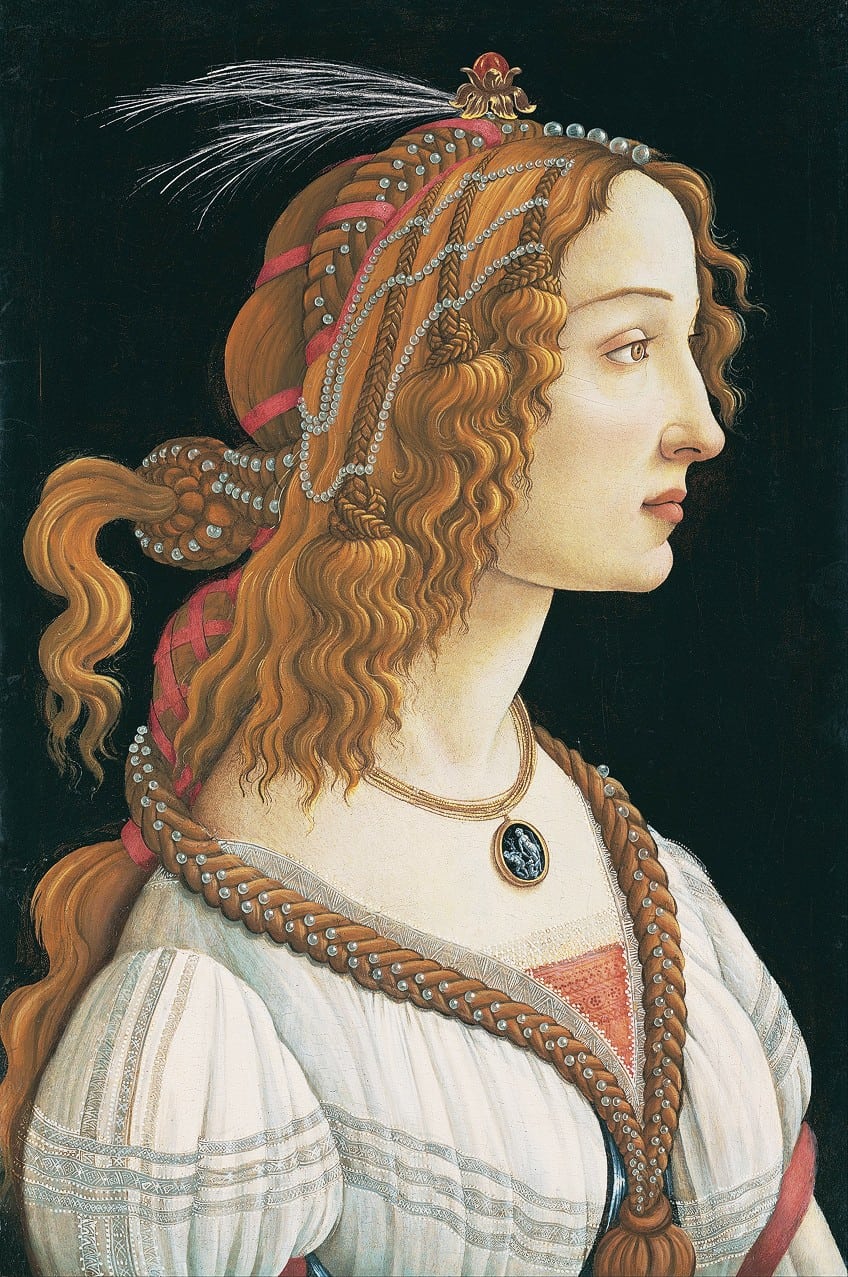
Some have also believed that the wasps represented the ideas of pain associated with love, in other words, that there is a potential “sting” associated with Venus and that Mars could be stung by love for her. There has been a wide scholarly debate around the myriads of meanings that could underlie the motifs Botticelli included. Furthermore, there is also wide speculation that the noblewoman Simonette Vespucci could have been the model for Botticelli when he painted the composition.
She was married to Marco Vespucci and was reportedly praised for her beauty, but this cannot be certain as the year of her death was 1476.
Venus and Mars Symbolism
One of the most notable symbolic meanings inherent in the Venus and Mars painting is the widely proposed idea that “love conquers war”. This is evident in how Venus is awake, and the god Mars is asleep, unaware of his surroundings and undoubtedly in a state of vulnerability.
Interestingly, another meaning attributed to the subject matter suggests that Venus and Mars could have just had sexual intercourse.
However, the truth of this has been questioned, because as much as Mars is semi-nude, Venus is fully clothed, and some have also attributed her attire to symbolize purity or virtue and the characteristics of that of a married woman, which would be fitting for the purpose of the painting for a newlywed couple.
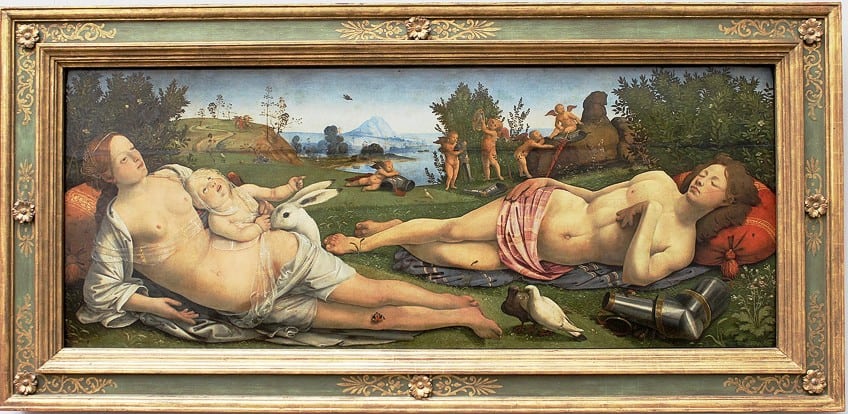
Furthermore, other reasons why this painting could have been for the bedroom was that it would act as a visual depiction of so-called beauty that would positively influence the process of procreation between the married couple, as well as be a visual display of the wealth of the family. The Venus and Mars depicted in Botticelli’s painting have also been associated with the mythological story around Venus’ love affair with the god Mars while she was married to Vulcan, the god of fire.
To expose Venus and Mars, Vulcan reportedly created a net that entrapped them. The net has been described as very “fine” and “invisible,” so that the couple would not know they were in it.
Venus and Mars Inspiration
Venus and Mars by Sandro Botticelli was also believed to be inspired by an ekphrasis (this is commonly defined as a “written description” of a visual composition) by the writer called Lucian of Samosata. He reportedly wrote a description of a painting about the wedding of Alexander the Great and Roxana.
In the description, Lucian recounted how there were several “cupids”, some helping Roxana and ushering her and Alexander to each other, and others, who were also more mischievous in nature, playing with Alexander’s weapons and armor.
Formal Analysis: A Brief Compositional Overview
Venus and Mars by Sandro Botticelli depicts a somewhat playful scene with two of the most well-known deities from Roman mythology. Let us take a closer look at this subject matter and how the artist executed it.
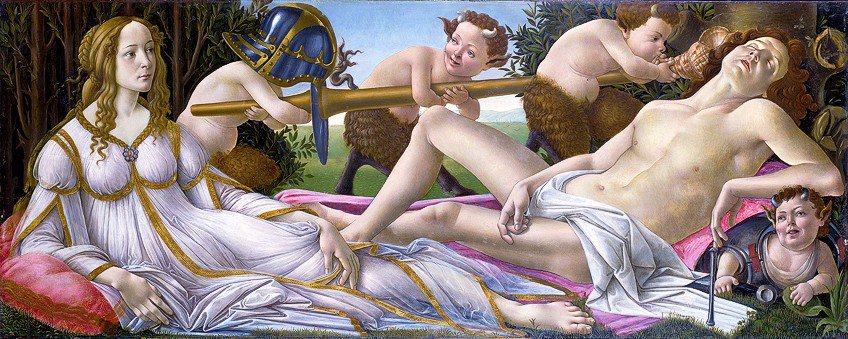
Subject Matter: Visual Description
The Mars and Venus painting depicts the goddess of love, Venus, to the left, and the god of war, Mars, to the right. They are both restful and in repose on a pink blanket on a patch of green grass in the foreground. Venus is awake, her right elbow is resting on a soft pink cushion and her left arm and hand are loosely resting over her leg, which is stretched out in front of her. She is wearing a fine long dress and looking ahead of her.
Mars is asleep and none the wiser about what is occurring around him. His head is tilted backward, his mouth is slightly open, and he is assumed to be snoring.
His left leg is stretched out in front of him, and his right leg is propped up and over his other leg. He is nude except for a white cloth covering his genital area. Behind the two figures and in the middle ground are three satyrs (these are known as “nature spirits”; their lower bodies are animal-like, and their upper bodies are human) who are sneakily playing and hunched over with what appears to be Mars’ weapon, which is a lance, and his helmet.

The satyr to the left is wearing the helmet and we cannot deduce its face while it is holding onto the lance’s handle. The middle satyr is helping to carry the lance and the satyr to the right is blowing a shell into Mars’ right ear, without waking the sleeping god. There is a fourth satyr in the lower right corner, inside a suit of armor with Mars’ elbow on top of it.
In the top right corner, there is a wasp’s nest in what appears to be an open tree branch, with several wasps flying around Mars’ head and hair. There appear to be noises coming from all around the sleeping god, but he continues his slumber.
In the middle foreground to the left and behind Venus is a grove of trees and to the right a larger tree behind Mars, both open in the center to a background consisting of a vast unknown green landscape with mountains in the distance and a clear blue sky. Interestingly, the trees in the background have been thought to be myrtle and laurel trees. The myrtle tree has been associated with the goddess Venus and the laurel trees are associated with the Medici family.
Color
The color scheme in Venus and Mars by Sandro Botticelli consists of light hues like whites, pinks, greens, browns, and bronzy golds without any stark contrasts. The lightness of the hues throughout the composition creates unity and color harmony and some of the patches of darker shading, for example in the trees to the left and right, create a sense of depth.
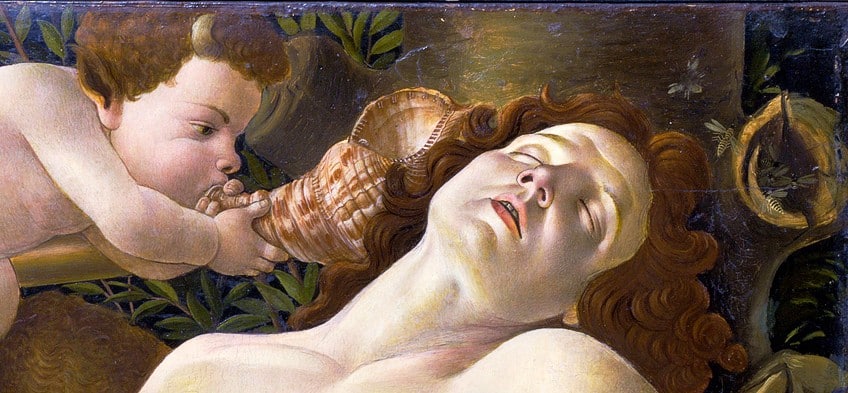
Texture
Sandro Botticelli applied smooth brushstrokes giving the composition a finer quality, and there are implied textures, for example, the diaphanous surface quality of Venus’ dress and its many folds in the foreground suggesting lightness, the smooth skin of all the figures, and the fine slivers of grass in the foreground, among others.

Line
Sandro Botticelli‘s artwork is characterized by his utilization of outlines or otherwise known as “contour lines”, which are noticeable in the Venus and Mars painting, for example around Mars’ right hand and Venus’ left hand, notice the outlines around their fingernails.
This is also noticed in the satyrs and their fingers. However, more than that, the outlines create more definitions of the forms.
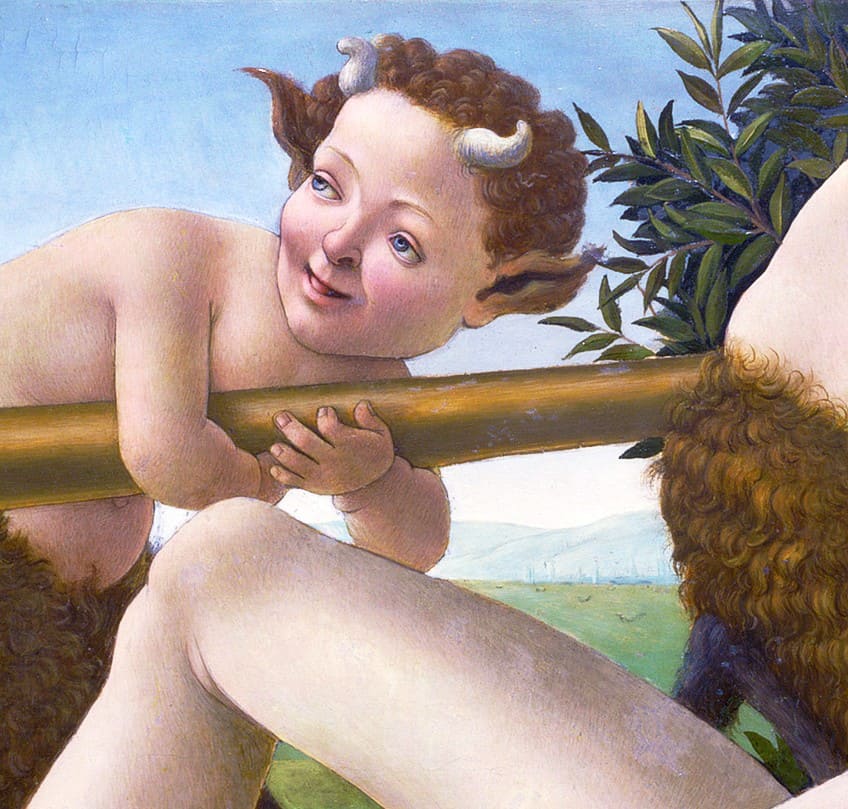
There is also a horizontal linearity formed from the orientation of the painting, which is also indicated in the straight horizontal line formed by Mars’ lance, the directional line implied by the satyrs walking towards the right (creating a sense of movement), as well as the way Mars and Venus are reclining. There are some vertical lines created by the trees on either side of the composition as well as curved lines created by the folds of the fabrics.
Shape and Form
The shapes and forms in Venus and Mars by Sandro Botticelli are natural and organic, in other words, they follow the forms of nature, although the proportion of Venus and Mars’ figures do not echo exact proportions in real life, one example includes Mars and Venus’ legs, specifically Venus’ legs which appear somewhat confusing in terms of where is left and right.
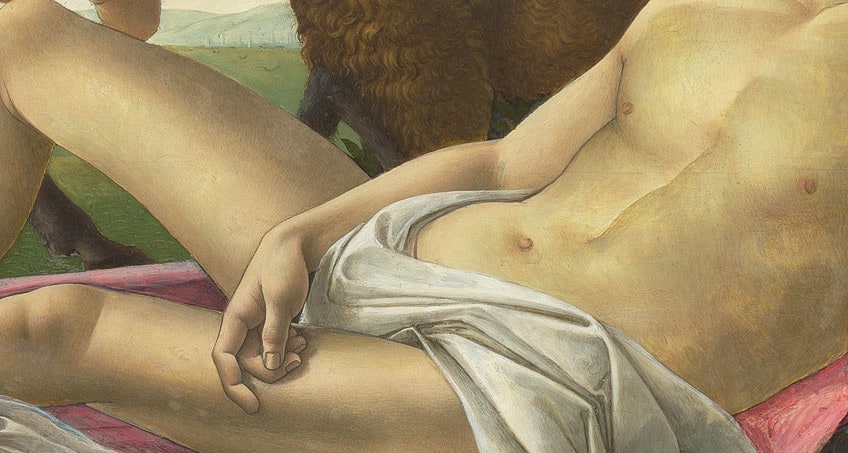
Space
The figures of Venus and Mars are placed directly in the foreground of Venus and Mars by Sandro Botticelli as if we (the viewers) can touch them or become part of the scene. The trees to the left and right in the middle ground seemingly create a backdrop effect, which brings Venus and Mars more into our space.
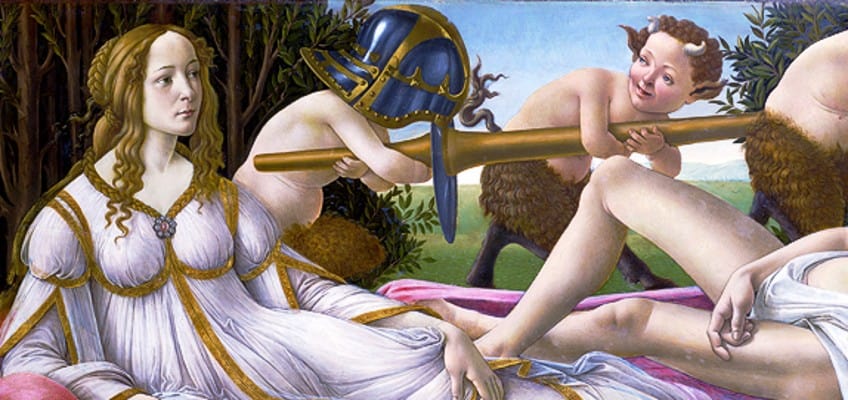
A Beautiful Gaze
This article discussed the Venus and Mars painting analysis, discussing who may have commissioned Sandro Botticelli to paint it as well as the story around Venus and Mars. We also discussed a formal analysis, providing a brief overview of the subject matter as well as the artist’s stylistic approaches in terms of the art elements.
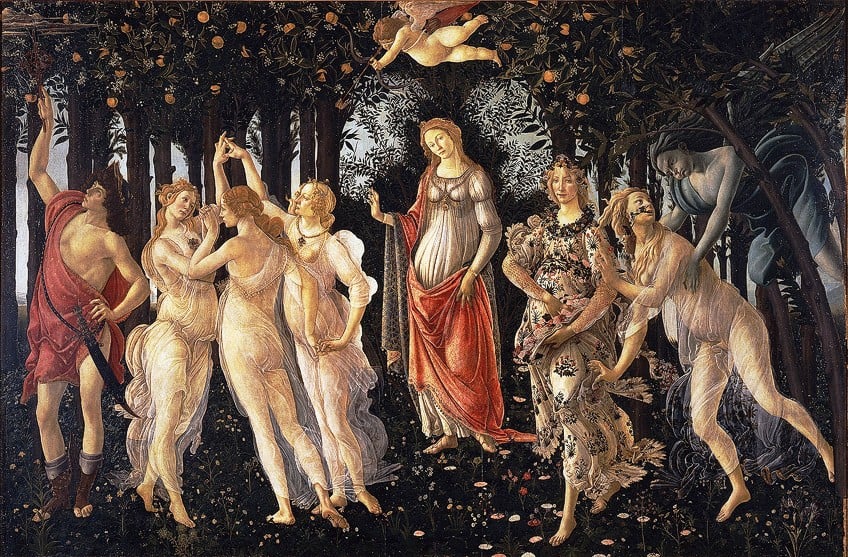
While we have only touched the surface of Sandro Botticelli’s artwork, we nonetheless have come face-to-face with the early Renaissance artist’s depiction of beauty through mythological subject matter that was possibly created as a wedding gift to be hung in a bedroom.
Botticelli’s sleeping Mars and gazing Venus is a scene that transports us to ideas of love, passionate pastimes, marriage, fidelity (and infidelity), and mythological scenes laden with symbolism. These mythological meanderings, so to say, were so often the case for paintings like the above, especially a work by one of the foremost painters of the early Renaissance that we have all come to adore, Sandro Botticelli!
Take a look at our Venus and Mars painting webstory here!
Frequently Asked Questions
Who Painted Venus and Mars?
Sandro Botticelli, the early Renaissance artist, painted the tempera and oil Venus and Mars (c. 1485). It depicts the Roman goddess of love, known as Venus, and the god of war, known as Mars. Botticelli also painted the famous Primavera (c. 1482) and The Birth of Venus (c. 1485), which are both housed at the Uffizi Gallery in Florence, Italy.
Where Is the Venus and Mars Painting?
The Venus and Mars (c. 1485) painting by Sandro Botticelli is housed at the National Gallery in London, England. The gallery bought it in 1874 for £1,050 at an auction, which was held to sell items from the collection of Alexander Barker.
What Is the Venus and Mars Painting About?
Venus and Mars (c. 1485) by Sandro Botticelli is about the Roman goddess Venus and the god Mars. More specifically, the painting depicts the tale of their affair with one another while Venus was still married to the god of fire, Vulcan, who reportedly cast a so-called invisible net around them to catch them in their infidelity.
Alicia du Plessis is a multidisciplinary writer. She completed her Bachelor of Arts degree, majoring in Art History and Classical Civilization, as well as two Honors, namely, in Art History and Education and Development, at the University of KwaZulu-Natal, South Africa. For her main Honors project in Art History, she explored perceptions of the San Bushmen’s identity and the concept of the “Other”. She has also looked at the use of photography in art and how it has been used to portray people’s lives.
Alicia’s other areas of interest in Art History include the process of writing about Art History and how to analyze paintings. Some of her favorite art movements include Impressionism and German Expressionism. She is yet to complete her Masters in Art History (she would like to do this abroad in Europe) having given it some time to first develop more professional experience with the interest to one day lecture it too.
Alicia has been working for artincontext.com since 2021 as an author and art history expert. She has specialized in painting analysis and is covering most of our painting analysis.
Learn more about Alicia du Plessis and the Art in Context Team.
Cite this Article
Alicia, du Plessis, ““Venus and Mars” by Sandro Botticelli – A Closer Look at the Work.” Art in Context. March 30, 2023. URL: https://artincontext.org/venus-and-mars-by-sandro-botticelli/
du Plessis, A. (2023, 30 March). “Venus and Mars” by Sandro Botticelli – A Closer Look at the Work. Art in Context. https://artincontext.org/venus-and-mars-by-sandro-botticelli/
du Plessis, Alicia. ““Venus and Mars” by Sandro Botticelli – A Closer Look at the Work.” Art in Context, March 30, 2023. https://artincontext.org/venus-and-mars-by-sandro-botticelli/.


